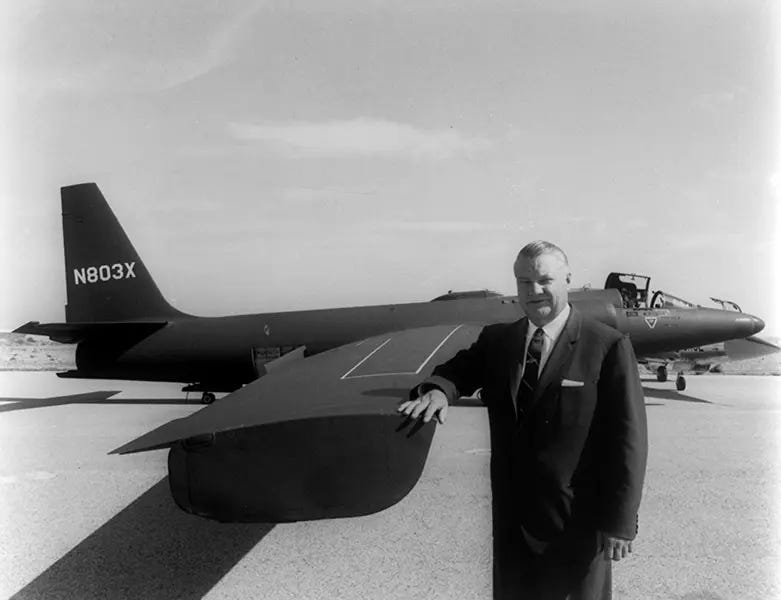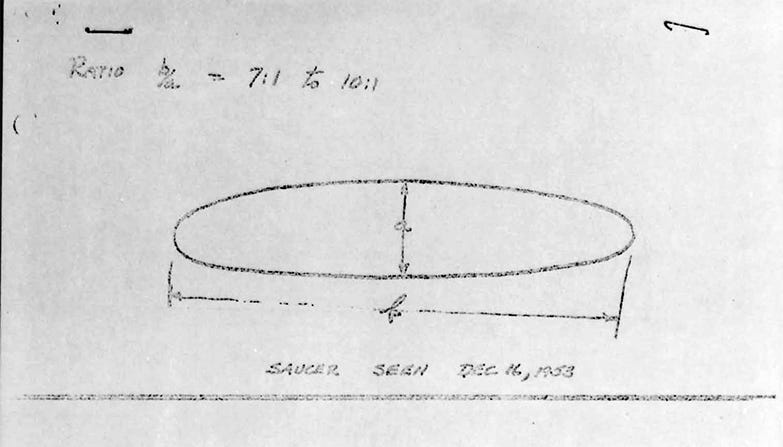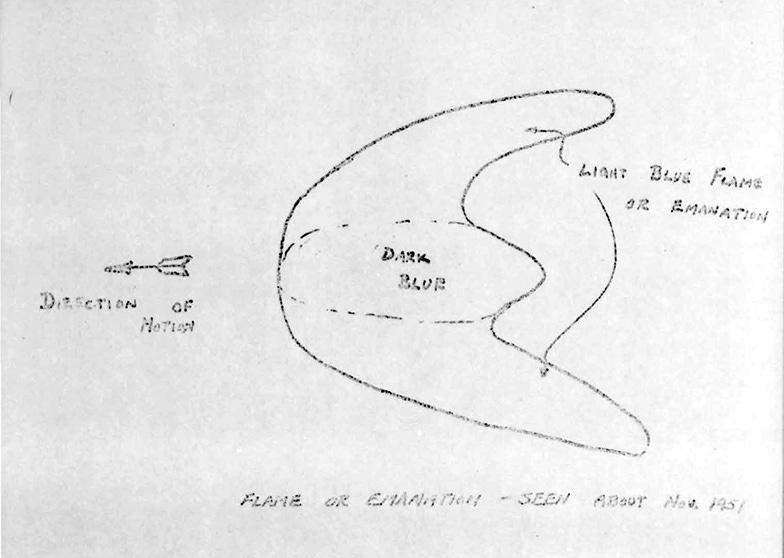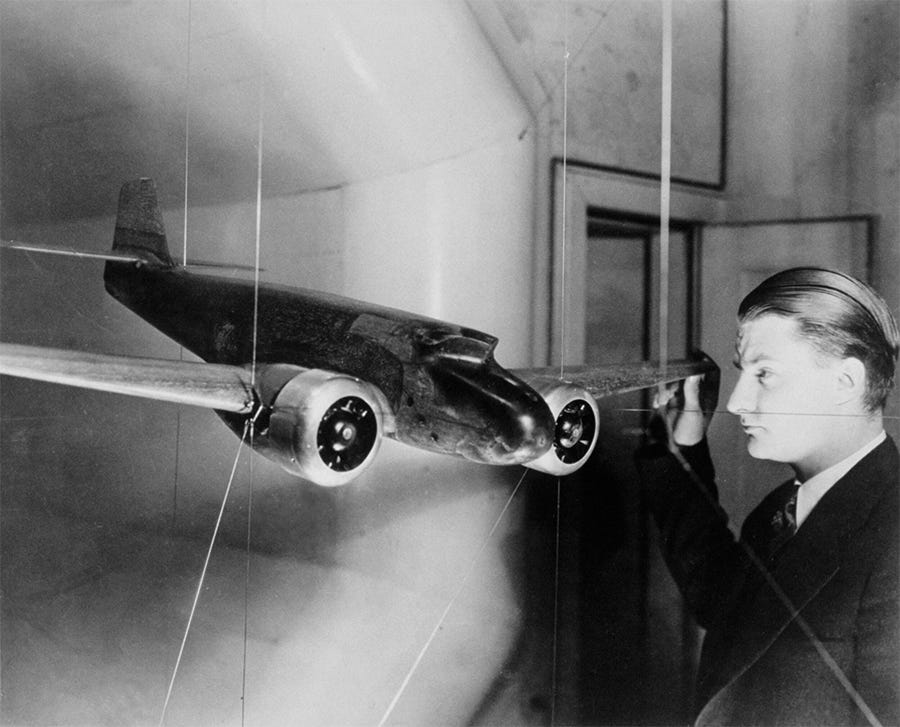U-2 Designer, UFO Witness
What Kelly Johnson, His Wife and a Lockheed Constellation Loaded with Experts Reported
In his role as a leading aeronautical engineer at Lockheed Corporation, Clarence Leonard “Kelly” Johnson helped design and build some of the most important aircraft in history. His work includes the P-38 Lightning, the P-80 Shooting Star, the F-104 Starfighter, and the U-2 Dragon Lady and YA-12 Blackbird spy planes.
Born in Ishpeming, Michigan in 1910, Kelly Johnson was a 1932 graduate of the University of Michigan, where he earned a bachelor of science degree in aeronautical engineering. He returned to U-M the following year, earning a master’s in aeronautical engineering, focusing on superchargers and boundary layer control. He joined Lockheed Corporation in 1933 and would rise there to become lead designer. He also founded the legendary Skunk Works advanced aeronautical design team at Lockheed, famed for speedy delivery of leading-edge aircraft.
Kelly Johnson, accompanied by his wife Althea, witnessed two extraordinary events while living in Southern California. In 1951, from a roadside in the mountains near their home northwest of Los Angeles, they observed a luminous, blue “flying saucer” in flight at night. Two years later, the couple saw and reported a second unidentified object from their home, a dark disk-like object.
What makes the second case extraordinary: flying over the nearby ocean was an experimental radar-dome equipped Lockheed Constellation, a four-engined, triple-tailed aircraft Kelly Johnson had helped design, on a test flight. Filled with pilots, engineers, and other experts, they, too, witnessed the same object from the air. Furthermore, they chronicled their individual accounts and officially attested to what “Certain Lockheed Personnel Witnessed” to the “Air Force Investigation Group on Flying Saucers” at Wright Field, Ohio.
At the Lockheed offices the next day, members of the Constellation air crew went in to the office reluctant to discuss what they had seen. At the time, the US Air Force and CIA were doing all they could to tamp down the reality of the UFO phenomenon, rationalizing away most all reports. Many in authority heaped ridicule on witnesses.
One of the test pilots, however, did describe the experience of the Constellation aircrew to Kelly Johnson. It was a moment of synchronicity, as Johnson was interested in sharing what he and his wife had seen from their home. What’s more, neither fear of professional ridicule nor fear of losing vital government contracts prevented Kelly Johnson and his colleagues from chronicling and reporting the Lockheed UFO encounter to the US Air Force.
Details and links to the report are below. Following is the sketch Mr. Johnson drew of the object he and his wife observed with binoculars on the ground — and corroborated by his Lockheed colleagues from the air:
The Lockheed UFO Incident
From The International UFO Reporter via NICAP (emphases FJB):
On December 16, 1953 Johnson and his wife Althea were visiting their Lindero Ranch near Agoura, California, which was situated on a hillside facing the coast not far from Pt Mugu Naval Air Station, an aircraft and missile test facility. At about 5 PM Johnson was looking through a window at the brilliant sunset when he noticed a dark elliptical shape in the sky in the direction of Pt Mugu cape. His first thought was that it was a lenticular cloud, or possibly a smoke trail from an aircraft, but it remained stationary and unchanged for several minutes. He called for Althea to bring him his 8-power binoculars and ran outside. By that time the object had begun to move, accelerating away from him in a shallow climb in a direction opposite to the motion of the other clouds in the sky. It seemed to be very large and distant, and moving fast, but he had no real way of knowing its actual size, distance or speed.
At the same time, coincidentally, a Lockheed airplane was in the air on a test flight along the Los Angeles coastline. Constellation airframe 4301 was the prototype for a Navy Airborne Early Warning (AEW) aircraft, the WV-2 Warning Star. The WV-2 was a large four-engine transport equipped with huge blisters housing radar antennas (a search radar unit in the belly and a height-finder in a dorsal fairing), and was designed to fly very long standing patrols far off the coasts of North America to provide long-range detection of incoming Soviet bombers. Constellation 4301 was the first of a long line of Navy WV-2s and Air Force EC-121s that would provide a vital part of the North American air defense network throughout the 1950s and '60s.
At the controls of the Warning Star were Rudy Thoren and Roy Wimmer, both highly experienced senior test pilots in the Constellation program, assisted by Joseph F. Ware, Jr, another longtime Lockheed engineering test pilot.[3] Also in the cockpit were Charlie Grugan, another veteran company pilot, and Lockheed's Chief Aerodynamicist, Philip A Colman. It was customary for Lockheed engineers to ride aboard their planes during test flights, and Johnson himself often did so. (There are no indications that the elaborate radar systems, which required a crew of at least a dozen men, were active during the flight.)
Thoren had been recruited by Johnson from their alma mater, the aeronautical engineering school at University of Michigan, and had been Chief of Flight Test for Lockheed since 1946, in charge of all the company's test pilots. Colman was a Cal Tech graduate who had made valuable contributions to the P-38 program, and who would soon be tasked by Johnson with designing the wings for the new CL-282 recon plane. All of the crewmen were top representatives of their fields, having flown for the company for years in development programs of a variety of sophisticated aircraft.
The exact purpose of the test flight is not detailed in the sighting reports, but such flights typically involved calibration of airspeed vs engine power settings at various altitudes, and therefore the crewmen were very conscious of the height of the aircraft. Altitude recording instruments were carried on board.
Though Wimmer was technically the pilot in command, he had turned the controls over to Thoren and was maintaining a watch for other air traffic as Thoren conducted his tests. They had turned from a southeast heading to west, just off the coast of Long Beach, when, at 4:58 PM, Wimmer noticed a dark shape ahead at about their altitude of 14,000 feet. After watching it for a few moments and noting that it was not moving, he jokingly pointed it out to Thoren, saying "Look out, there's a flying saucer." Thoren turned the WV-2 a bit to the right to head toward the object. The other men saw the object too and watched it for a few minutes with a growing sense of curiosity. It appeared to be a very large aircraft of some type, but as it remained stationary and unchanged in shape over at least a five minute period, they became more and more intrigued. Thoren finally diverted from his course and headed directly at it. They flew toward it at about 225 mph for some time without appearing to gain on it at all. Then Wimmer, who was less occupied with piloting tasks and was able to keep a constant watch on the object, commented that it seemed to be disappearing. Within a few moments it appeared to head west directly away from them at high speed, remaining dark and solid-looking the entire time as it dwindled to a tiny dot. They all felt that it was a large object at a considerable distance, and compared its size to the largest types of transport or bomber aircraft. The men later reported that they thought little more of the incident at the time due to their preoccupation with completing the test mission, but Thoren was intrigued enough that upon returning home that evening he told his family about the sighting and sketched the object.
The following day, Kelly Johnson had returned to work and was discussing the WV-2 test flight with Thoren, who was still ruminating on the incident. A bit worried that Johnson would ridicule him, the pilot casually mentioned the sighting. Thoren was surprised when Johnson excitedly interrupted him and described his own sighting in detail. Both concluded that all the witnesses had been viewing the same object at the same time. Over the course of the next few weeks each of the pilots wrote a detailed personal account of the case, probably at Johnson's urging, and the Chief Engineer, in his typical meticulous style, assembled them into a file (Lockheed file LAC/149536) and drafted a personal cover letter addressed to the "Air Force Investigation Group on Flying Saucers" at Wright Field. Then, tough and combative as he was, Johnson hesitated to send the report. After all, he was hoping to get a foot in the door of the Air Force's new covert strategic reconnaissance aircraft competition and was very concerned that a UFO report might jeopardize his credibility. He may have sought the advice of his friend, Lt General Donald Putt.
ARDC commander Putt, who had the responsibility for reviewing and approving new Air Force reconnaissance projects like Johnson's CL-282, had also had a long, if intermittent, association with the UFO problem. A former test pilot with a solid Cal Tech engineering background, Putt was one of the stars of the Air Force, having risen to prominence as project officer for the B-29 bomber during WWII. Closely allied with Theodore von Karman's Scientific Advisory Board (he would be its military supervisor for several years), Putt had helped make science and advanced technology the backbone of the emerging air service. He had been commander of T-2 Air Intelligence during a crucial period following the end of hostilities in Europe and had been a strong backer of Operation Paperclip, the transfer of German aeronautical scientists to Wright Field. A widely-respected, politically savvy officer, Putt showed little evidence of the antipathy to UFOs that many other Air Force generals exhibited. In December 1948 Project RAND missile expert James Lipp had written a paper at Putt's request that examined the possibility that UFOs were extraterrestrial spacecraft that used propulsion principles comparable to known or foreseeable rocket technology. (The fascinating paper was published as an appendix to the final report of Project SIGN.)
Continues…
The Case File and Its Implications
Although the sighting was not highly dramatic in comparison to many UFO reports, what makes it particularly unusual - and scientifically useful - is that it was a long-duration daylight sighting of an object seen by two independent groups of observers. Moreover, these groups - one stationary and one moving - were separated by very long baselines in both horizontal and vertical planes, facilitating triangulation of the object's position. One group even had the advantage of using optical instruments to view the UFO. Unlike many sensationalized UFO events, these observations were recorded in a calm, professional manner by the witnesses themselves while the details were still fresh in their minds. No media attention was sought or desired. And most importantly, the integrity and competence of this particular group of observers is almost unquestionable. A more qualified set of eyewitnesses would be hard to imagine.
Because of their precise observations and careful documentation of the incident, a great deal of information can be extracted from the account. Available weather data makes it clear that Blue Book's rubber-stamp identification of the object as a lenticular cloud is untenable...and therefore the object's identity is still a mystery.
There was no question in about this in Kelly Johnson’s view. He was absolutely certain that it was no cloud, aircraft or other mundane object.
The case file reveals a multitude of intriguing threads, including references to prior sightings by several of the engineers. Johnson furnished two signed sketches with his report. One showed the December 1953 object, a simple flattened ellipse, but the second, dated "about November 1951," shows a strange object resembling a rounded, sweptback flying wing aircraft. In his written account, Johnson elaborates:
I should also state that about two years ago Mrs. Johnson and I saw an object which I believed at the time, and still do, to be a saucer, flying west of Brents Junction, California, on a very dark night. I did not see the object itself but saw a clearly defined flame or emanation, as shown on the attached sketch. This object was traveling from east to west at a very high speed and with no noise. The flame or emanation was a beautiful light blue, having extremely well defined edges. My first impression was that it was an afterburning airplane, but the lack of noise and the pure spread of the flame eliminated that possibility completely.
(Brents Junction is a small town just east of Johnson's Agoura ranch.)
Roy Wimmer mentioned in his report that he had seen mysterious lights over Santa Catalina Island sometime in 1951 or 1952 during a flight in Constellation 1961S, the original prototype of the Constellation line.
— The International UFO Reporter via NICAP
Kelly Johnson positions an early model Lockheed Electra in the University of Michigan wind tunnel. His analysis found the airframe unstable at the airspeeds made possible by its two powerful engines. His solution was to add a second vertical stabilizer, creating a twin-tailed aircraft.
The Michigan Man Who Became Tom Swift
From the University of Michigan “Kelly Johnson to the Rescue”
Clarence Leonard Johnson was born in Ishpeming, Michigan, in 1910, the seventh of nine children born to Swedish immigrants Christine and Peter Johnson. Young Clarence found school so intriguing that he showed up early every morning just to be the first to get inside.
It was in school where a bully named Cecil—who made fun of Clarence by calling him Clara—pushed Clarence one too many times. Johnson got in a tumble with Cecil, broke his leg, and told his teacher and the principal that he had done it on purpose. Johnson was rapped hard on the knuckles with a ruler but didn’t cry, which brought him favor with his peers—who thought a more appropriate moniker for such a tough guy would be a good fighting Irish name like “Kelly.”
The nickname stuck.
Johnson’s parents instilled a love of learning in their children and encouraged them to read on their own. Kelly went to the library nearly every day. He loved the Tom Swift books: Tom Swift and His Aeroplane, Tom Swift and His Electric Automobile, Tom Swift and His Submarine. It became Kelly’s goal to be just like Tom—a highly skilled designer, pilot, engineer, and adventurer—and at age 12 he decided to be an aircraft designer. “My whole life from that time was aimed at preparing for that goal,” he said.
In 1923, when he was 13, his family moved to Flint. After completing high school, he enrolled at Flint Junior College, taking engineering courses for the first time, along with physics, mathematics, and calculus. He also took his first airplane flight—and thought that if he wanted to design planes, he should learn how to fly. But the instructor talked him out of it, saying he’d go further in life by attending a university.
Johnson enrolled at U-M in 1929. While he appreciated the splendor of its sprawling campus, the source of its “real beauty” for Johnson was its distinguished faculty in aeronautical engineering. His mentors included Felix Pawlowski, who had worked in Russia with Igor Sikorsky on the world’s first four-engine airplane and trained with Alexandre Gustave Eiffel, designer of the Paris tower. Pawlowski brought U-M its first wind tunnel and the inaugural aeronautical curriculum, and worked with Johnson in class and at the wind tunnel in the East Engineering Building.
Johnson understood his professors as broad-minded people who took a sincere interest in their students. Edward A. Stalker, head of the aeronautical department, helped Johnson plan his course of study. Soon he selected him as his student assistant, enabling Johnson to quit his lowly job in a fraternity house kitchen and become deeply involved in wind tunnel testing.
Other professors he admired included O.W. Boston, the Timoshenko brothers, and Walter Lay, an automotive engines expert. This was “heady stuff for the kid from Ishpeming who wanted to be like Tom Swift,” he would later write. “It was an exciting adventure, associating with some of the best minds in every field important to a would-be engineer.”
Kelly spent most of his time working, studying, and tutoring. There was little time to play. He had one very good friend named Don Palmer and admitted to “lonely times”—trudging across campus after dinner for more wind tunnel work or correcting papers for professors. Though he was a student during Prohibition and “home brew,” which he says others in his boarding house imbibed, Johnson was very much against drink. In his three years on campus, Kelly went on just two dates.
“I didn’t have time for romance, and I deliberately avoided any entanglement,” he said. “There would be no detours from my goal.”
— University of Michigan
Sources & Credits:
International UFO Reporter: Kelly’s Angels: The Lockheed UFO Case
PDF file: Sighting of a Flying Saucer by Certain Lockheed Personnel
Project 1947: A Study of the Lockheed Sightings
The UFO Database: The 1953 Lockheed Sightings
The University of Michigan: Kelly Johnson to the Rescue
Ars Technica: Kelly’s Heroes: Lockheed’s Five Finest Planes
This Day in Aviation: Clarence Leonard (“Kelly”) Johnson (27 February 1910–21 December 1990)







